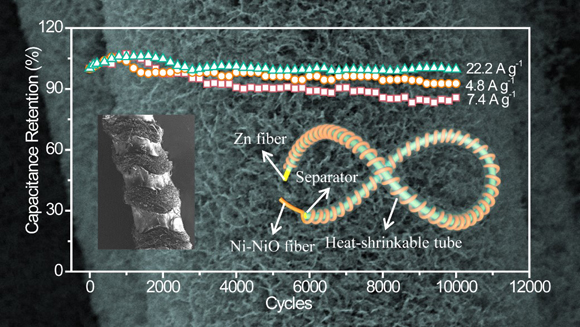An Ultrastable and High-Performance Flexible Fiber-Shaped Ni–Zn Battery based on a Ni–NiO Heterostructured Nanosheet Cathode
Source: School of Chemistry
Written by: School of Chemistry
Edited by: Wang Dongmei
To keep pace with the ever-growing pursuit of wearable and portable electronics, it is scientifically important to develop matchable energy-storage devices with tiny volume, light weight, good flexibility, and wearability. Particularly, fibershaped energy-storage devices, such as fiber supercapacitors, fiber Li-ion batteries, and fiber metal-air batteries, have attracted increasing interests for their knittability and widespread applications in on-body equipment. Of the energy storage devices developed, Ni–Zn battery is a sustainable and promising alternative to lithium-ion battery owing to its merits of intrinsically good safety, abundant resource, high capacity, and output voltage (≈1.8 V). Unfortunately, the commercialization of Ni–Zn battery is plagued by its poor cycling stability in terms of the irreversibility of Ni-based cathode and dendrite formation of the Zn anode during the charging–discharging processes. Thus, the search for economical, environmental, and feasible approaches to synthesize high-performance Ni-based cathode materials for flexible quasi/all-solid-state rechargeable Ni–Zn battery is highly challenging and pursued.

Recently, Associate Professor Xihong Lu and Professor Mingmei Wu from the School of Chemistry at Sun Yat-sen University constituted the first demonstration of an ultrastable and high-performance flexible quasi-solid-state fiber-shaped Ni–Zn battery based on Ni/NiO heterostructured nanosheet cathode. The interconnected Ni/NiO heterojunction nanoparticles and tunable metallic Ni content of such porous Ni/NiO nanosheets enable them remarkably enhanced conductivity, fast ion diffusion rate, and high electrolyte penetration. As a consequence, the as-fabricated quasi-solid-state fiber-shaped Ni–Zn battery delivered a remarkable capacity of 237.8 μAh cm−3, together with a peak energy density of 6.6 μWh cm−2, outperforming most reported fiber-shaped energy-storage devices. More encouragingly, the as-fabricated quasi-solid-state fiber-shaped Ni–Zn battery not only possessed outstanding flexibility but also owned prominent long-term stability even at different current densities (almost no capacity attenuation after 10 000 cycles at 22.2 A g−1). This work has been published in Adv. Mater. (Yinxiang Zeng, Yue Meng, Zhengzhe Lai, Xiyue Zhang, Minghao Yu, Pingping Fang, Mingmei Wu*, Yexiang Tong and Xihong Lu* Adv. Mater., 2017, 29(44), 1702698). The title is “An Ultrastable and High-Performance Flexible Fiber-Shaped Ni–Zn Battery based on a Ni–NiO Heterostructured Nanosheet Cathode”.
The authors acknowledge the financial support of the National Natural Science Foundation of China, Guangdong Natural Science Funds for Distinguished Young Scholar, National Key R&D Program of China, Tip-top Scientific and Technical Innovative Youth Talents of Guangdong Special Support Program, Pearl River Nova Program of Guangzhou and so on.
Link to the article:
http://onlinelibrary.wiley.com/wol1/doi/10.1002/adma.201702698/full
